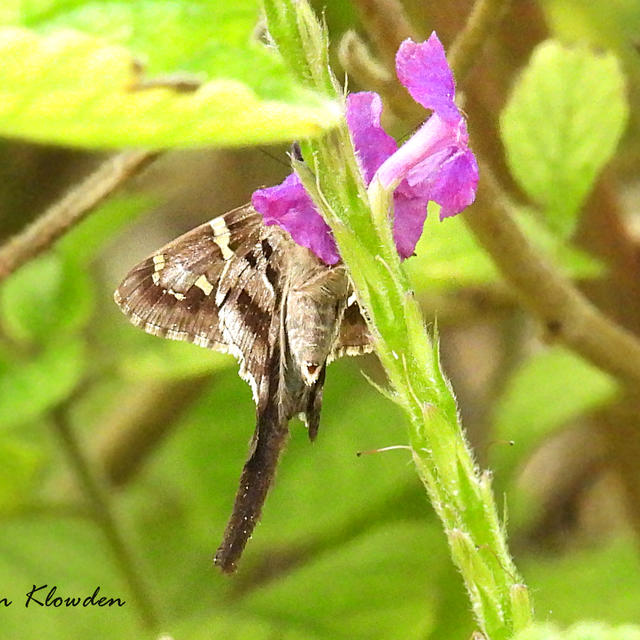Long-tailed Skipper
Urbanus proteus (Linnaeus, 1758)
Family: Hesperiidae
Subfamily: Pyrginae
Identification: Tails are long. Upperside is dark blackish brown; body and wing bases are iridescent blue-green. Males have a costal fold enclosing scent scales on the leading edge of the forewing. Dark row on underside of hindwing is a complete band.
Wing Span: 1 3/4 - 2 5/16 inches (4.5 - 6 cm).
Life History: Adults roost upside down under leaves and limbs. To seek females, males perch 3-6 feet above the ground in sunlit openings. Females lay eggs under leaves in clusters of up to 20. Caterpillars feed on leaves and live in shelters of rolled leaves.
Flight: Two to three broods throughout the year in south Florida and South Texas.
Caterpillar Hosts: Vine legumes including various beans (Phaseolus), hog peanuts (Amphicarpa bracteata), beggar's ticks (Desmodium), blue peas (Clitoria), and wisteria (Wisteria).
Adult Food: Flower nectar from a variety of plants including bougainvillea, lantana, and shepherd's needle.
Habitat: Brushy fields, edges of woods, gardens, and other disturbed open habitats.
Range: Argentina north through Central America, the West Indies, and Mexico to peninsular Florida and South Texas. Occasionally strays and colonizes north to Connecticut, southern Illinois, eastern Kansas, southern Arizona, and southern California.
Conservation: Not usually required.
NCGR: G5 - Demonstrably secure globally, though it may be quite rare in parts of its range, especially at the periphery.
Management Needs: Urbanus proteus caterpillars are sometimes pests on snap beans.
Get your BAMONA Gear!
Please donate!
We depend on donations to keep Butterflies and Moths of North America freely available. We want to express our gratitude to all who showed their support by making a contribution this year. You can donate to support this project at any time.
Advertise with us!
Do you have a product or service that you think would interest BAMONA users? If you would like to advertise on this website, contact us by email, or use the contact form and select the "Advertising" category.
Verified Sightings
Displaying 73 - 96 of 2000 verified sightings

Observation date: Oct 09, 2018
Submitted by: Iván Guerrero C...
Region: Mexico
Verified by: Paul Prappas
Verified date: Jan 26, 2023

Observation date: Nov 05, 2017
Submitted by: pasicam
Region: Mexico
Verified by: Paul Prappas
Verified date: Jan 24, 2023

Observation date: Feb 12, 2016
Submitted by: Arabella S Dane
Region: Mexico
Verified by: Paul Prappas
Verified date: Jan 24, 2023

Observation date: Oct 20, 2021
Submitted by: David F Smith
Region: Sonora, Mexico
Verified by: stevecary
Verified date: Jan 24, 2023

Observation date: Dec 17, 2022
Submitted by: Ron Klowden
Region: St. Lucie County, Florida, United States
Verified by: John Calhoun
Verified date: Jan 02, 2023

Observation date: Oct 01, 2022
Submitted by: hsmarshall
Region: Orleans Parish, Louisiana, United States
Verified by: CA Ivy
Verified date: Dec 14, 2022

Observation date: Nov 07, 2022
Submitted by: Robert Gorman
Region: Cameron County, Texas, United States
Verified by: jwileyrains
Verified date: Dec 08, 2022

Observation date: Nov 15, 2022
Submitted by: John Gibbons
Region: Pinellas County, Florida, United States
Verified by: John Calhoun
Verified date: Nov 18, 2022

Observation date: Nov 08, 2022
Submitted by: Bill Uttenweiler
Region: Brevard County, Florida, United States
Verified by: John Calhoun
Verified date: Nov 09, 2022

Observation date: Nov 09, 2022
Submitted by: KShell
Region: Dixie County, Florida, United States
Verified by: John Calhoun
Verified date: Nov 09, 2022

Observation date: Nov 08, 2022
Submitted by: SM_TN
Region: Union County, Tennessee, United States
Verified by: James Steen
Verified date: Nov 08, 2022

Observation date: Nov 04, 2022
Submitted by: Steve Edwards
Region: Lancaster County, South Carolina, United States
Verified by: Dennis Forsythe
Verified date: Nov 05, 2022

Observation date: Nov 04, 2022
Submitted by: Hypersiug.
Region: Polk County, Florida, United States
Verified by: curtis.lehman
Verified date: Nov 04, 2022

Observation date: Nov 04, 2022
Submitted by: Hypersiug.
Region: Polk County, Florida, United States
Verified by: curtis.lehman
Verified date: Nov 04, 2022

Observation date: Sep 12, 2022
Submitted by: bchensel
Region: Brevard County, Florida, United States
Verified by: John Calhoun
Verified date: Nov 01, 2022

Observation date: Oct 24, 2022
Submitted by: Bill Uttenweiler
Region: Brevard County, Florida, United States
Verified by: John Calhoun
Verified date: Nov 01, 2022

Observation date: Oct 29, 2022
Submitted by: philsfotos1
Region: Carteret County, North Carolina, United States
Verified by: Dennis Forsythe
Verified date: Oct 30, 2022

Observation date: Oct 26, 2022
Submitted by: Charles_Mills
Region: Bowie County, Texas, United States
Verified by: jwileyrains
Verified date: Oct 26, 2022

Observation date: Oct 24, 2022
Submitted by: JamieLynn
Region: Aiken County, South Carolina, United States
Verified by: Dennis Forsythe
Verified date: Oct 26, 2022

Observation date: Mar 11, 2015
Submitted by: tom murray
Region: Puntarenas, Costa Rica
Verified by: Paul Prappas
Verified date: Oct 25, 2022

Observation date: Mar 18, 2014
Submitted by: mikeakresh
Region: The Bahamas
Verified by: Paul Prappas
Verified date: Oct 24, 2022

Observation date: Jan 09, 2015
Submitted by: Jody
Region: Jamaica
Verified by: Paul Prappas
Verified date: Oct 23, 2022

Observation date: May 09, 2019
Submitted by: Ana Olivo
Region: Dominican Republic
Verified by: Paul Prappas
Verified date: Oct 22, 2022

Observation date: Oct 14, 2022
Submitted by: Ken Cheeks
Region: Aiken County, South Carolina, United States
Verified by: Dennis Forsythe
Verified date: Oct 22, 2022
- ‹ previous
- 4 of 84
- next ›








